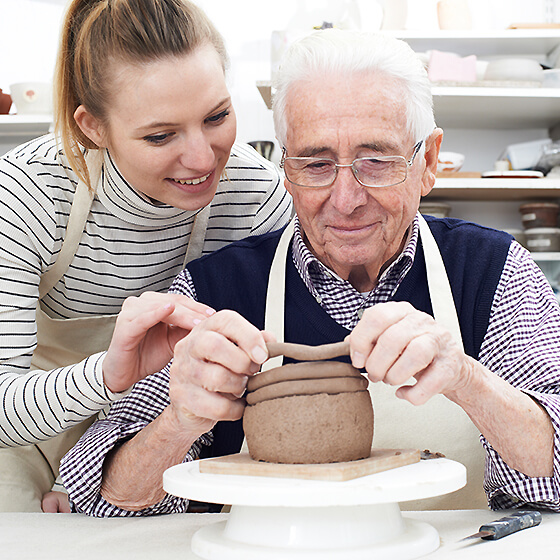Art therapy is the subject of modern discussions around rehabilitation and enrichment for people in need of self-care or wellness-based activities. Art therapy for the elderly has grown in interest as a tool for increasing the quality of life for seniors, especially seniors with dementia or other cognitive disabilities as it has been shown to have a favorable effect on their treatment process. As well, art therapy is flexible and accessible which allows for seniors of varying socioeconomic statuses to reap the benefits by participating in ways that make sense for them.
What is Art Therapy?
Art therapy is the process of using creative activities to build a connection to themselves and others. Art therapy is more visual, kinesthetic and sensory than verbal communications so it opens up the opportunity for connection with oneself, create deeper communication with others and build community through a common interest. This connection to their self and others can lead to a decrease in isolation and depression and an increase in emotional and physical well-being. Art therapy can be any medium of artistic expression, including dancing, poetry, painting, pottery, drawing, singing or playing a musical instrument.
Benefits of Art Therapy
Seniors who have participated in art therapy have stated they have a higher quality of life due to the effect the practice has on their lives and their personal goals. Each person will have unique goals and preferences, but regardless of the style of art, some positive effects have been noted.
- Fostered sense of accomplishment from the act of creating a piece of art they are proud of.
- Promoting communication with those who have difficulty expressing their thoughts and feelings, thus reducing isolation and loneliness.
- Reduction in stress, depression and anxiety.
- Increase in general physical ability including fine motor skills, gross motor skills and a decrease in fragility.
- Increase in mental wellness including cognitive function, memory, and self-regulation.
- Increased ability for coping with strong emotions, memories and changes in routine.
How to Get Started
If art therapy is a practice that interests you or an elderly loved one, look for community resources in your area. There may be options for ‘Paint Nights’ at local community centers, scrapbooking at your personal place of worship, or in-home opportunities hosted by your private caregiver or a home care services professional. Ensure that the art your loved one chooses is one that they will feel is meaningful, as well as safe for them to participate in. Depending on your circumstances, it may be appropriate to use caution around dangerous tools and toxic materials. Providing emotional support during this process can be hugely beneficial in boosting morale and self-esteem. Some ways to help are starting the senior off with options they can succeed at, such as an abstract watercolor or drawing with larger markers. As they succeed and improve, ensure you are complimenting their work and encouraging them to continue practicing. Getting them emotionally involved can be integral to artistic inspiration. Using materials, they find joy in, such as bright colors and a subject they care about like a childhood vacation or a beloved pet can be the best inspiration. Once they finish their art, if it is a physical product like a drawing or painting, try presenting it in a place of honor, or sending it as a gift to a friend. This will build their sense of accomplishment and self-esteem.
Art therapy can be a great practice for rehabilitation alongside medication, physical therapy and a dedicated caregiver. Art enriches our lives with feeling and flavor, it is no wonder we fill our homes with art and pay to visit famous museums. Art therapy allows us to slow down, focus and connect with our feelings and our friends. This meditative practice can be the perfect accompaniment to a balanced life of retirement.
We also recommend you check these related articles in our Home Care Services blog:

